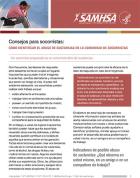This wallet-size card includes the national Disaster Distress Helpline and lists warning signs of distress. It encourages those experiencing signs of psychological stress to call or text the helpline for support.
Dashboard: Filter Bricks
Main page content


This brochure features the national Disaster Distress Helpline, which supports people who are coping with the after effects of a disaster. Learn about a disasters’ potential to cause psychological stress, warning signs of distress, and tips for coping.

This flyer highlights key Psychological First Aid concepts and resources disaster responders and outreach workers may use when assisting individuals affected by the pandemic. It also provides resources for further assistance.

Ayuda a los socorristas a identificar cuáles son las señales de advertencia del uso indebido del alcohol, de medicamentos recetados y de otras sustancias. Repasa los indicadores físicos, emocionales, sociales, conductuales y mentales de un posible abuso de sustancias y ayuda a determinar cuándo deben buscar ayuda.

In a disaster, it's essential that behavioral health responders have the resources they need—when and where they need them. The free SAMHSA Disaster App offers first responders immediate access for any type of traumatic event at every phase of response, including pre-deployment preparation, on-the-ground assistance and post-deployment resources.
With the SAMHSA Disaster App, first responders can:
- Access resources including tip sheets; guides for responders, teachers, parents, and caregivers; and a directory of behavioral health service providers in the impacted area.
- Download information on your phone before deployment in case of limited Internet connectivity in the field.
- Review key preparedness materials to help you provide the best support possible.
- Send information to colleagues and survivors via text message, email, or transfer to a computer for printing.
- Find interventions to help survivors of infectious disease epidemics.
Find SAMHSA’s disaster response information as a publication. Download the SAMHSA Disaster Kit.
For more information, email SAMHSA at samhsainfo@samhsa.hhs.gov

This wallet card helps counselors identify people at risk for suicide. It presents information on what to do if someone is having suicidal thoughts, and lists warning signs of suicidal behavior. The card also gives the number to the National Suicide Prevention Lifeline.

Punjabi version of KEN01-0093, prompted by a violent incident at a Sikh temple in Wisconsin in August 2012. Helps parents and teachers recognize and address problems in children and teens affected by the trauma after an act of violence. Describes signs of stress reactions that are common in young trauma survivors at different ages, and offers tips on how to help.

This wallet-size card includes the national Disaster Distress Helpline and lists warning signs of distress. It encourages those experiencing signs of psychological stress to call or text the helpline for support.

This brochure features the national Disaster Distress Helpline, which supports people who are coping with the after effects of a disaster. Learn about a disasters’ potential to cause psychological stress, warning signs of distress, and tips for coping.

